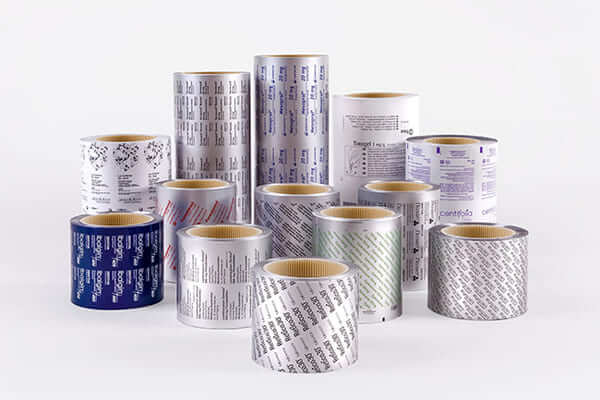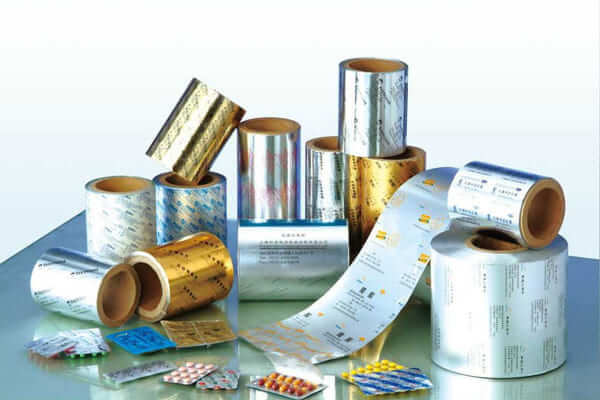What is Aluminium Blister Foil
Aluminium blister foil is a type of packaging material used for pharmaceutical products. It is made of aluminum foil that is coated with a protective layer, usually a heat-seal lacquer, to form a blister pack. Blister packs are used to package tablets, capsules, and other solid dosage forms. The foil provides a barrier against moisture, oxygen, and light, helping to protect the medication from degradation. The blister packs are usually sealed with a lidding material, such as PVC, to create a secure and tamper-evident package.
 Aluminium Blister Foil with diffirent print
Aluminium Blister Foil with diffirent printWhy is blister packaging so popular for pharmaceutical products?
Protection: Blister packs provide a barrier against moisture, oxygen, and light, which helps protect the medication from degradation and maintains its potency and effectiveness.
Tamper-evidence: Blister packs are usually sealed with a lidding material that is difficult to tamper with, providing a level of security and ensuring that the product has not been opened or altered before purchase.
Convenience: Blister packs are easy to handle and store, and they provide a convenient way to dispense medication, especially for products that need to be taken in specific doses or at specific times.
Portability: Blister packs are compact and lightweight, making them easy to transport and carry, which is especially important for medications that need to be taken while traveling or on the go.
Compliance: Blister packs can be designed with individual compartments for each dose, making it easier for patients to comply with their prescribed dosage regimen.
Marketing: Blister packs offer a convenient platform for branding and product information, which can help with marketing and differentiation of the product in the market.
Common alloys of Blister Aluminum Foil
Blister aluminum foil is typically made from aluminum alloy 8011-H18 or 8021-O. These alloys are chosen for their suitability for the specific requirements of blister packaging, including their:
- Barrier properties: These alloys provide excellent barrier properties against moisture, oxygen, and light, which helps protect the medication from degradation.
- Formability: The alloys are easily formable into the desired shape and can be easily cut and sealed, making them ideal for creating blister packs.
- Compatibility: They are compatible with the heat-seal lacquers and other materials used in blister packaging, ensuring a secure seal and proper protection of the medication.
- Strength: The alloys provide the necessary strength and puncture resistance to protect the medication during handling and transportation.
- Cost-effectiveness: These alloys are cost-effective compared to other materials used in blister packaging, making them a popular choice for pharmaceutical manufacturers.
Specification of blister aluminum foil
Blister aluminum foil specifications can vary depending on the specific requirements of the application, but some common specifications include:
| Alloy | Blister aluminum foil is typically made from aluminum alloy 8011-H18 or 8021-O. |
| Thickness | The thickness of blister aluminum foil is usually between 20-30 microns. Thinner foils are used for forming the blister cavities, while thicker foils are used for the outer layers of the blister pack. |
| Width | The width of blister aluminum foil can vary depending on the requirements of the blister packaging machine, but standard widths are typically between 100-600 mm. |
| Surface | The surface of blister aluminum foil is usually treated with a heat-seal lacquer to facilitate sealing with the lidding material. The surface can also be printed with product information or branding. |
| Color | Blister aluminum foil is typically silver in color, but it can be coated or printed in different colors as per the requirements of the packaging design. |
| Barrier properties | Blister aluminum foil should have excellent barrier properties against moisture, oxygen, and light to protect the medication from degradation. |
| Packing | Blister aluminum foil is usually packed in rolls or sheets, depending on the requirements of the packaging machine and the volume of production. |
Advantages of Blister Aluminum Foil
- Barrier properties: Blister aluminum foil provides an excellent barrier against moisture, oxygen, and light, which helps protect the medication from degradation and maintain its potency.
- Tamper-evidence: Blister packs are sealed with a lidding material that is difficult to tamper with, providing a level of security and ensuring that the product has not been opened or altered before purchase.
- Convenience: Blister packs are easy to handle and store, and they provide a convenient way to dispense medication, especially for products that need to be taken in specific doses or at specific times.
- Compliance: Blister packs can be designed with individual compartments for each dose, making it easier for patients to comply with their prescribed dosage regimen.
- Portability: Blister packs are compact and lightweight, making them easy to transport and carry, which is especially important for medications that need to be taken while traveling or on the go.
- Customization: Blister aluminum foil can be easily customized to meet the specific requirements of the pharmaceutical product, including the size, shape, and design of the blister pack.
- Cost-effective: Blister aluminum foil is cost-effective compared to other packaging materials, making it an economical choice for pharmaceutical manufacturers.
 Aluminium Blister Foil application
Aluminium Blister Foil applicationAluminum Blister Foil production process
Aluminum foil rolling: The process begins with rolling aluminum ingots into thin sheets. These sheets are rolled multiple times until the desired thickness is achieved. The rolling process also improves the mechanical properties of the foil.
Annealing: After rolling, the foil is annealed to soften it and improve its ductility. Annealing involves heating the foil to a specific temperature and then cooling it slowly to room temperature.
Coating: The foil is coated with a protective layer, usually a heat-seal lacquer, to improve its barrier properties and enable it to be sealed to the blister pack.
Printing: The foil may be printed with product information, branding, or other details using a printing process. This step is optional and depends on the requirements of the packaging design.
Slitting: The foil is slit into the desired width to meet the requirements of the blister packaging machine.
Cutting: The foil is cut into individual sheets or rolls, depending on the packaging requirements.
Packing: The finished foil is packed in rolls or sheets, ready to be used in blister packaging machines.
